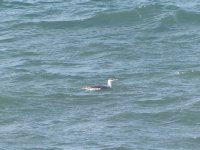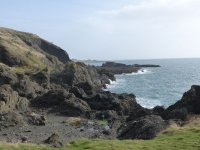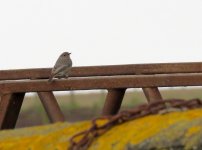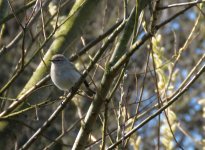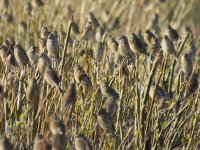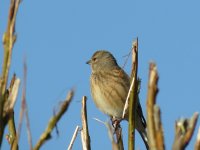Kincraig and Ruddons Points
I had been taking it relatively easy for the last three or four days due to the effects of a virus, but as today would be my last day watching before I headed offshore, I was determined to head out.
My plan all week had been to try and catch a better look at the Brent Geese at the Eden Estuary. A day sat in the hides of the Eden Centre and at Balgove Bay, also seemed to be the wisest thing as the virus was still hanging onto me. Also, I'd picked up a few niggling leg and foot injuries over the last few months, so again, the wisest thing to do would be to head for the estuary hides.
Then the alert came in yesterday afternoon. Red-Necked Grebe and Slavonian Grebes off Ruddons Point. Two lifers in the offering. The grebes and divers of Largo Bay had been giving me the slip since January, and I'd pretty much written them of till next winter, but here was a possibility of changing all that. All I had to do was ignore my body and doing the wisest thing.
Twenty to eleven found me rolling into the upper car park at Shell Bay, with the wisest thing duly ignored. High tide was due at about a quarter past fifteen. Plan was to be out on Ruddons Point a couple of hours before high tide. First bird of the day was a Robin at the edge of the car park. Walking down the tarmac road that leads into Shell Bay, I added a distant Yellowhammer, and then at the roadside, a fully hooded Reed Bunting.
Shell bay was already half flooded by the advancing tide. Its waters glistened under a bright sun and clear sky. In the bay I started my day's count of Herring Gull, Curlew, Oystercatcher and Eider.In the fields to the east, there were Carrion Crow patrolling the freshly ploughed ground.
I had never been out to Kincraig Point before, so with time to spare, I decided to explore. I followed a small muddy track that led between the ploughed fields and the short drop down onto the rocks of the coastline. Skylark was added to the list here.
As the path curved away east from Shell Bay, I spotted a bird, fairly close in, out on the water. There fishing just off the rocks was a fine looking Red-Throated Diver. I spent some time watching this specimen in its winter garb before tearing myself away. As I left, I contemplated how I would be able to fulfil a long held ambition to see one of these fantastic birds in summer dress. A trip to Shetland seemed the logical answer.
The path now ascended a steep set of steps up to the cliff tops of the point. At the top I found old WW2 pill boxes. The tremendous view from this vantage point explained their placement. Approaching the cliff edge at the largest pill box, a Pheasant exploded out of the long grasses in front of me. The waters down below however, were barren in bird terms.
With time getting on, I started to retrace my steps. I relocated the R-T Diver in about the same place as before. Further out though, I also found four Guillemot, and then three Red breasted Merganser . Before leaving the path at the back of Shell bay, I also found a couple of Mallard on the seaweed covered rocks at the waters edge.
Feeling a little under par at this point, I took the easier route along the caravan park road that skirts the back of Shell Bay's dunes, rather than trudge through the soft sands on the beach. Along this road I located Pied Wagtail and Blackbird. I headed for the gap in the stand of conifers that marks the point where the Cocklemill Burn flows out past the high water mark on the Largo Bay beach. The time was a quarter past twelve, so although the tide was pretty high, I still had a little time. Along the beach there were few birds and nothing that I had not already listed, so I decided to head into the Cocklemill Marsh.
Approaching the first of the two wooded foot bridges that enable the crossing of the marsh, a small flock of Chaffinch took to the air and disappeared over the burn. Approaching the second bridge, a flock of forty plus Curlew flew overhead and settled in a field just beyond the marsh. Heading back towards the first bridge, I was overtaken by four Rock Pipits. They were all Scandinavian type. I briefly wondered whether subspecies count as a separate tick on lists. I decided it wasn't really important to me at this stage. I was just glad in the progress that enabled me to tell the difference.
Back up on the path, I now headed up the west side of Ruddon's Point. Great Black-Backed Gull was added to the list, and the Mallard count significantly increased.
Out along the point, I could feel the full force of the wind. I'd checked the forecast before leaving and knew it would be borderline tolerable, but it certainly wasn't comfortable, even to someone who has spent the last twenty five years working offshore.
About halfway along this west side of the point, there is a bit of a rise that makes a good scanning point. With the binoculars, it took quite a while to find much out on the water. I noted a very distant group of Scoter, but my attention was grabbed by finding my second Red-Throated Diver of the day. Again, close in and actively fishing the rising tide. For the first time of the day, I set up the tripod and scope for better views. Relocating the bird with the scope afforded excellent views between dives. At one point I looked away to wipe a wind induced tear from my eye. looking back again, I found not only the R-T Diver, but a drake Long-Tailed Duck sitting next to it.
With the wind starting to strength a little, it was getting harder to focus the scope as my body moved from the buffeting gusts. Birds on the water were easier to see with a bit of height due to the choppy waves, however, I moved to a lower, slightly more sheltered, vantage point where an outfall pipe runs into Largo Bay off the point. It was from here that I picked up three dark duck in the air. I was able to pick out the white bars that identified them as Velvet Scoter. Their arrival reminded me I hadn't checked out the far off group of Scoter. I found them with the scope, but the rise and call of the rolling waves made things very difficult, especially at the edge of max range they were sat at. I watched for a while and decided there was nothing showing to say they were not Common Scoter, so I listed them as such.
I continued scanning for my prime targets of Red-Necked and Slavonian Grebe, but I could find nothing. Stepping back from the scope at one point, I realised I had been scanning over the top of a close in bird. My excitement level rapidly rose. The R-T Diver was still showing in the area, but this was not that bird. This bird was a lot darker, had no white in the face and its throat was dark. My instinct was Black-Throated Diver. I raised my binoculars to my eyes and proved my instinct wrong, as this bird had a deep red throat. Another R-T Diver, but this one in the summer garb that I had for many years longed to see it in. Grebes were now all but forgotten. I was made up, and had just saved a trip to Shetland (although I think that may well happen anyway at some point).
The bird dived soon after I got the binoculars on it. I struggled to relocate it, but when I did, it was moving away from the area. I also moved away from the area. This time I headed for the end of the point. My intention was to find a Whimbrel that is known to roost out on the little island formed by the high tide. It is reported to sit there with the Curlews of the area displaced by the high tide. There was no Whimbrel. There were no Curlew. I suddenly realised that there were forty plus of them on the far side of the Cocklemill Marsh. I wondered if my Whimbrel was with them.
There were birds on the island however, mainly more Oystercatcher, but also, strangely enough, my first Turnstone, Cormorant and Redshank of the day. On the water to the leeward side of the island I also found plenty of Eider and also twenty eight Red-Breasted Merganser.
It was nigh on high tide now, so I decided to call it a day. I headed back along the west side of the point, giving Largo bay a final scan or two for Grebes. I found none, but did locate a flock of Wigeon near the burn mouth.
Returning to the car through the caravan park, I listed my last bird of the day, as six magpies flew between and over the caravans.
Photo 1 - R-T Diver
Photo 2 - View east from Kincraig Point
Photo 3 - View of Ruddons Point from Kincraig Point.





